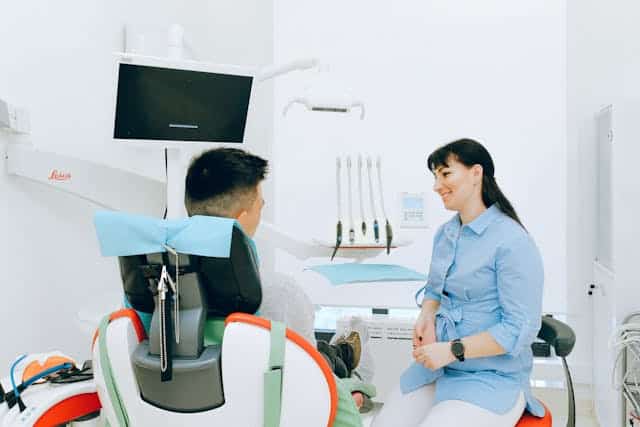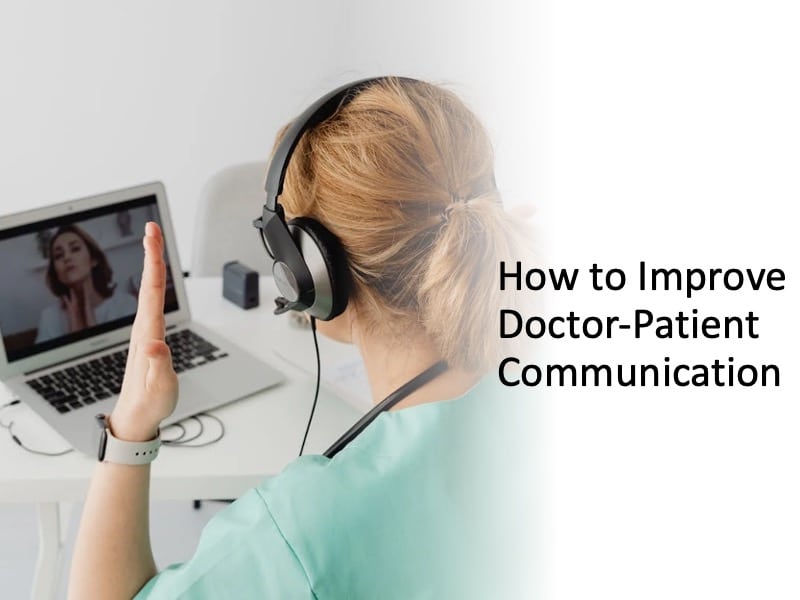How to Improve Doctor-Patient Communication
If you’re looking to improve doctor-patient communication, you’re not just boosting the quality of care, you’re transforming the entire healthcare experience.
Communication is the backbone of trust, treatment adherence, and patient satisfaction.
In fact, up to 80% of serious medical errors can be linked to breakdowns in communication between healthcare providers and patients (Riesenberg, 2012).
But let’s be honest—communication often feels like a juggling act, especially in high-volume practices like dentistry.
Between managing schedules, explaining procedures, calming nerves, and handling insurance questions, front-desk staff carry the emotional and administrative weight of the entire clinic.
Burnout is inevitable when systems don’t support meaningful interaction. This is one of the reasons self-care for healthcare workers is so important, as they have to deal with such an overload of different jobs.
But improving communication doesn’t mean piling on more tasks.
It means designing smarter systems that prioritize clarity, intentional delegation, and space for real conversations instead of reactive chaos.
With the right tools, culture, and daily habits, even small changes can have a major impact.
Whether you run a solo dental practice or a busy healthcare clinic, these strategies will help you improve doctor-patient communication in ways that are human-centered, sustainable, and immediately effective.
Why is Doctor-Patient Communication Important?

Clear and compassionate communication between doctors and patients is foundational to high-quality care.
When patients understand their diagnosis, treatment options, and next steps, they are more likely to follow through, experience better outcomes, and feel satisfied with their care.
Strong communication reduces the risk of medical errors, improves medication adherence, and strengthens trust in healthcare providers.
It also supports ethical, patient-centered care by ensuring patients can voice their concerns, preferences, and values (Ha & Longnecker, 2010).
From an operational standpoint, effective doctor-patient communication enhances scheduling efficiency, reduces appointment cancellations, and directly influences patient retention.
In fact, 69% of Americans would consider switching to another provider if they offered more appealing services, including better communication and convenience (The Harris Poll, 2022).
This reveals a shifting patient mindset, where clinical expertise must be matched with a seamless, compassionate experience.
Modern patients expect their healthcare journey to feel more like the intuitive service of apps like Amazon Prime or Uber.
More than 60% of Americans want their healthcare experience to reflect that level of customer service, and 81% say online scheduling would significantly improve convenience.
These expectations are directly tied to how well providers communicate and engage.
Moreover, kindness matters.
Over half of Americans (56%) cite kindness from the provider, and 52% from office staff, as essential during first-time visits, highlighting how every interaction counts, not just the clinical ones.
In an age of medical revolutions and digital transformation, communication isn’t just a soft skill, it’s a competitive advantage.
When practices prioritize human-first, emotionally intelligent interactions, they don’t just retain patients, they build communities of trust.
Examples of Doctor-Patient Communication

Doctor-patient communication isn’t limited to diagnosis or treatment explanations—it influences nearly every stage of the care process.
Here are a few examples that illustrate its critical role in both clinical outcomes and patient satisfaction:
Delivering a Diagnosis
Explaining a new diagnosis, especially one that’s chronic or life-changing, requires clarity, empathy, and careful pacing.
Rushed or overly technical language can create fear, confusion, and poor adherence to treatment plans.
Discussing Treatment Options
Patients should feel involved in decisions about their care.
A provider who explains the risks, benefits, and alternatives to treatment empowers the patient to make informed choices, which is a cornerstone of ethical, patient-centered care.
Addressing Pain or Discomfort
When patients report pain, the quality of the provider’s response can either validate their experience or lead to feelings of dismissal.
Acknowledging discomfort, asking clarifying questions, and offering solutions builds trust and improves care.
End-of-Life Conversations
Few interactions require as much compassion and communication skill as discussing hospice, palliative care, or do-not-resuscitate (DNR) orders.
These sensitive topics demand a calm, respectful tone and an emphasis on patient values and wishes.
Explaining Medication Use
Miscommunication about prescriptions can lead to non-adherence, side effects, or adverse reactions.
Clear explanations of when, how, and why to take medications, ideally supported by written instructions, help patients stay on track.
As more patients now order prescription medications online, providers must double-check that patients understand dosage, timing, and potential interactions without relying solely on digital instructions.
Following Up After a Procedure or Visit
A simple follow-up call or message shows patients that their provider cares beyond the appointment.
It reinforces instructions, answers residual questions, and encourages continued engagement with their care plan.
Handling Emotional Reactions
When patients express anxiety, anger, or fear, providers must listen attentively and respond with empathy.
Emotional regulation is a key skill in clinical communication that often distinguishes a good experience from a great one.
These scenarios represent more than just routine exchanges, they’re pivotal moments that shape how patients view their care, their doctor, and the healthcare system as a whole.
Common Problems with Doctor-Patient Communication

Despite the best intentions on both sides, communication breakdowns between healthcare providers and patients remain one of the leading causes of medical errors and dissatisfaction.
Recognizing these common issues is the first step to improving doctor-patient communication and building a more trust-based practice.
Medical Jargon Overload
Providers often use technical terms that can confuse or overwhelm patients.
Without clear, simplified explanations, patients may leave appointments unsure about their condition or treatment plan, leading to poor adherence and frustration.
Rushed Appointments
Time constraints are a major barrier.
When providers are forced to move quickly from one patient to the next, conversations can feel transactional instead of personal.
Patients may not feel heard, and important details can be missed.
One-Way Communication
A provider who dominates the conversation may unintentionally silence the patient.
True communication is collaborative, allowing space for patients to express their concerns, ask questions, and clarify their understanding.
Lack of Follow-Up
Even when communication during the visit is strong, failure to follow up can leave patients feeling abandoned.
Missed check-ins, unanswered questions, or confusion after appointments can erode trust and delay recovery.
Emotional Disconnect
Patients dealing with pain, fear, or anxiety need more than just clinical accuracy; they need empathy.
When providers seem distracted or emotionally distant, patients may hesitate to be open or honest, reducing the effectiveness of care.
Inconsistent Messaging Across the Team
When different team members give conflicting information about medications, scheduling, or post-visit instructions, patients lose confidence in the system.
Consistency is key to clarity and trust.
These challenges are not insurmountable.
With targeted improvements and a team-wide commitment to clarity and compassion, practices can eliminate these barriers and dramatically improve doctor-patient communication.
Most Effective Ways to Improve Doctor-Patient Communication

Improving doctor-patient communication is one of the most powerful strategies for enhancing patient care, reducing misunderstandings, and developing trust in clinical relationships.
Whether in a private practice or a busy hospital setting, small, intentional changes in how healthcare providers engage with patients can lead to significantly better outcomes.
When communication becomes clearer, more empathetic, and patient-focused, everyone benefits.
Patients feel empowered, and providers gain greater insight into patient needs, concerns, and values.
These practical strategies are designed to improve clinical efficiency without compromising human connection.
Redesign the First Touchpoint
Think of your phone line or front desk as your clinic’s handshake.
Is it confident, calm, and clear—or rushed, confused, and overwhelmed?
Redesigning your first touchpoint starts with reducing friction.
Are patients always calling to ask the same questions?
That’s a clue.
Instead of turning your front-desk team into a broken record, provide clear, beautifully designed materials that answer common questions before patients even reach the front door.
Think:
- A welcome email with FAQs and what to expect
- SMS appointment confirmations with direct reply options
- Laminated visual procedure guides for in-clinic check-in
You’re not replacing the human touch, you’re preserving it by removing unnecessary repetition.
Let your staff focus on the meaningful moments instead.
2.) Train Staff to Triage—Not Just Answer
This one is subtle, but powerful. It’s easy to assume every patient needs the same level of explanation or time.
They don’t. And your staff shouldn’t be expected to treat every interaction the same either.
Training your team to triage communication helps them understand the difference between:
- A patient needing a quick yes/no
- Someone who needs emotional reassurance
- A complex case that requires clinical explanation
This doesn’t require a new hire—just a shift in mindset and perhaps a basic communication protocol. Empower your front desk to route calls, book consults, or flag high-need patients for follow-up by the right person.
When everyone on your team knows their role in the communication flow, patients feel seen—and staff feel supported.
3.) Bring in a Virtual Assistant (Yes, a Real One)
One of the quiet medical revolutions transforming modern practices is the rise of virtual support, and telehealth visits aren’t the only example.
For example, a dental virtual assistant is a trained professional who works remotely yet integrates seamlessly into your team’s workflow.
These experts often come with a background in dental operations and understand patient expectations, clinical terminology, and the nuances of practice management.
From appointment scheduling and insurance verification to follow-up calls and pre-visit instructions, they handle essential tasks with consistency and care.
The benefit? Your in-house team can focus on high-touch moments like in-chair communication and front-desk hospitality, without being stretched thin.
A virtual assistant isn’t a substitute for human connection, they preserve it by handling the background noise that often gets in the way.
Because they work off-site, they’re often more focused and less distracted than multitasking in-office staff, helping your practice run smoother with fewer errors and more peace of mind.
4.) Use Micro-Training Moments to Level Up Communication
Most physician or dental practices wait for an annual workshop or quarterly training to discuss about communication.
But what if growth became part of the daily rhythm?
Introduce micro-training:
- 10-minute weekly standups
- “Call of the week” playback and review
- Roleplay sessions during slower hours
- Quick lunchtime learning videos
It doesn’t have to be formal or time-consuming.
The goal is to embed communication awareness into everyday culture.
Encourage staff to share what works, ask for help when unsure, and workshop better ways to handle tough conversations.
Little by little, you’ll build a team that listens better, explains more clearly and connects more confidently, without anyone feeling like it’s one more thing on their to-do list.
5.) Simplify Tech—Don’t Overload It
Let’s not kid ourselves: adding five platforms to “help” communication often makes it worse.
Staff bounce between apps, messages get missed, and no one knows which channel to check first.
Instead, simplify your tech stack.
Pick tools that work well together and train everyone thoroughly. Ideally, you want:
- A unified inbox for calls, texts, and emails
- Automated appointment confirmations and reminders
- Easy note-logging tied to patient files
- Video consults or follow-ups integrated into your main system
Good tech should reduce steps, not add them. It should feel like a helpful extension of your team, not another set of tools to master.
If your current software is clunky or confusing, ask your staff what they’d change.
Chances are, they already know what’s making things harder than they need to be.
Final Thoughts: Doctor-Patient Communication Shouldn’t Be a Burden
Your team didn’t sign up to be overwhelmed. They signed up to help people.
That’s the heart of any healthcare role.
When doctor-patient communication becomes another stressor, it doesn’t just hurt morale, it impacts the patient experience too.
But with thoughtful delegation, simplified systems, and just the right blend of human support (virtual or not), your practice can strike the perfect balance: warm, clear communication and a team that feels energized instead of exhausted.
Because when your staff are supported, your patients feel it. Every call, every visit, every smile.



